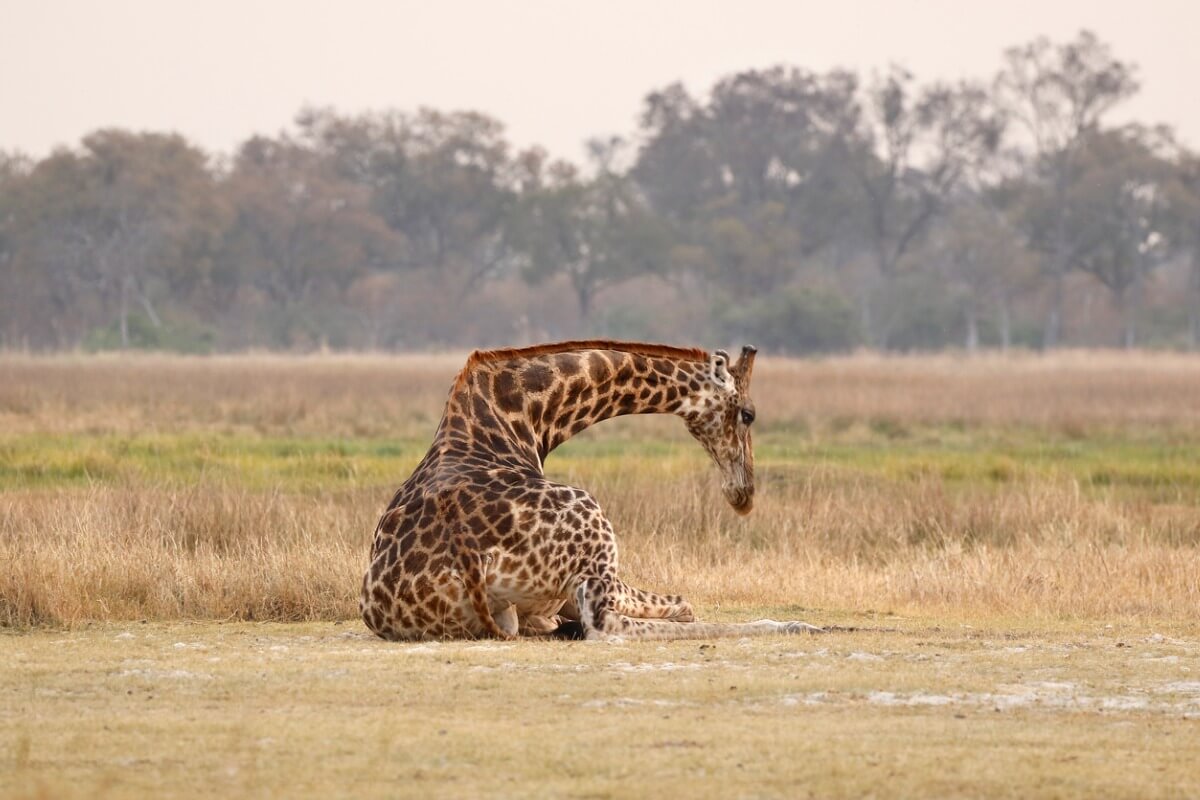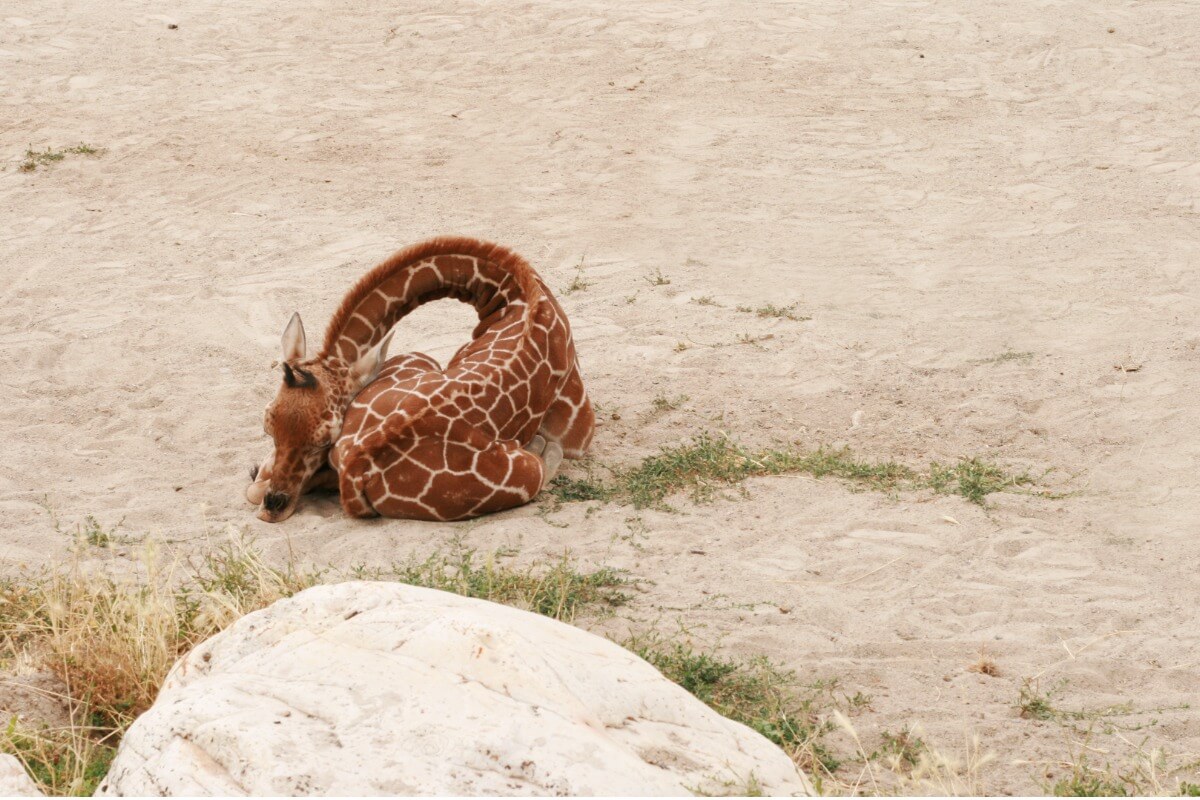How Do Giraffes Sleep?


Reviewed and approved by the psychologist Sara González Juárez
The amount that animals sleep varies widely depending on the conditions in which they live. Some mammals can sleep as little as 2 hours a day, while others rest for up to 18 hours or more in the same interval. The larger the living being, the more visible and vulnerable it will be when it’s sleeping. Anyway, on this theme, today we’re going to ask the following question: how do giraffes sleep?
Understanding how these enormous animals sleep is fascinating! Some experts actually believed that they didn’t sleep at all. Due to their size and prey status, giraffes have the shortest sleep requirement within the animal kingdom and their resting position is somewhat unusual from our point of view. Find out how they sleep here.
How long do giraffes sleep?
Giraffes (Giraffa camelopardalis), a species of mammals typical of Africa, are the tallest land animals in the world. They can reach a height of 5.8 meters (19 feet) and a weight that goes between 750 and 1600 kilograms (1650 to 3500 pounds). Their unique adaptation allows them to reach plants that no other herbivore can access.
These mammals sleep so little that some experts came to believe that they didn’t rest at all. With only 2 hours of sleep a day divided into short periods of 5 minutes, they can continue their day-to-day lives perfectly. Now compare this figure with a human, who requires up to 8 hours of uninterrupted rest to be able to function well.
As ruminants, giraffes spend long periods chewing and may sometimes get a little sleep in short periods. Although their appearance is slim, they eat a lot. They spend between 16 to 20 hours a day in search of plant matter, during which they can consume up to 140 pounds of organic matter. This is one of the reasons why they sleep so little.
The time that giraffes sleep depends on whether they live in captivity or in zoos, since in the latter they feel safer and less vulnerable, so their sleep periods are longer.

How do giraffes sleep?
Giraffes can be nature’s strangest sleepers. Normally, the adults rest on their feet to be alert for any predator. Their eyes remain half-open, their ears move all the time, and their bodies remain erect. All this indicates that their sleep isn’t at all deep.
However, when they’re young or feeling protected, giraffes can sleep lying on their legs and folding their necks over their back, a position that doesn’t look very comfortable. Experts say that, in this position, they have managed to sleep up to 4 hours in a row. Adults occasionally sleep like this too, but rarely for more than 5 minutes at a time.
Why do they sleep so little?
If you’ve ever gone all night without sleep, then the next day you were surely aware of the amount of time we humans need to have a truly restorative sleep and one which helps us function properly. In the wild, it’s another story, as there’s no roof or locked doors to protect the animals from threats.
The different sleep cycles of living beings have evolved over the centuries and sleeping can have a higher price for some, as it’s not a good idea to leave yourself vulnerable to attacks from another species. Professionals comment that even the most feared and successful predators don’t sleep anywhere near as soundly as humans, as they can’t afford to trust the environment.
In the case of lions, the main land predators in Africa, they rest for up to 20 hours a day. The big but here is that they do it through short, easy-to-interrupt “cat naps.” Unlike giraffes, felines are ready to spring into action much quicker upon awakening.
How vulnerable are they to getting so little sleep?
Imagine the tallest land animal in the world lying in the middle of a plain. A tempting feast for any predator, right? Giraffes are enormous and they usually run up to 35 miles per hour; one kick from them can kill any predator, so when they’re alert they aren’t an easy target.
If giraffes wanted to sleep lying on the ground and for long periods of time, this would bring unfortunate consequences. Standing up is an uncomfortable procedure for them, and they wouldn’t be able to defend themselves as they should. Neither do they have thick skin, built-in armor, or sharp teeth. They only have their height and strength, and after sleeping it takes a while for them to burst into action.

Did you know that these short-sleeping mammals are in danger of extinction?
The strategies they administer in their sleep cycle may protect giraffes from other animals, but not from the most savage and ruthless predator. Illegal hunting and the loss of habitats due to human population growth, the expansion of agriculture, and mining have put them at extreme risk, says the Aquae Foundation.
This species that inhabits Southern and Eastern Africa, with subpopulations in Central and Western Africa, has decreased between 36% and 40%. In 1985, there were approximately 160,000 of them, but, in 2015, the figures showed that there were just over 97,500 of them.
Giraffes have been studied so infrequently that, as we mentioned before, it was believed that they didn’t sleep at all. Today, in Africa, there are fewer giraffes left than elephants. Therefore, knowing about them and understanding their lives and the importance of their ecosystem is necessary for their conservation. They sleep very little to avoid predators, but this doesn’t save them from the greatest predator of all – human beings.
The amount that animals sleep varies widely depending on the conditions in which they live. Some mammals can sleep as little as 2 hours a day, while others rest for up to 18 hours or more in the same interval. The larger the living being, the more visible and vulnerable it will be when it’s sleeping. Anyway, on this theme, today we’re going to ask the following question: how do giraffes sleep?
Understanding how these enormous animals sleep is fascinating! Some experts actually believed that they didn’t sleep at all. Due to their size and prey status, giraffes have the shortest sleep requirement within the animal kingdom and their resting position is somewhat unusual from our point of view. Find out how they sleep here.
How long do giraffes sleep?
Giraffes (Giraffa camelopardalis), a species of mammals typical of Africa, are the tallest land animals in the world. They can reach a height of 5.8 meters (19 feet) and a weight that goes between 750 and 1600 kilograms (1650 to 3500 pounds). Their unique adaptation allows them to reach plants that no other herbivore can access.
These mammals sleep so little that some experts came to believe that they didn’t rest at all. With only 2 hours of sleep a day divided into short periods of 5 minutes, they can continue their day-to-day lives perfectly. Now compare this figure with a human, who requires up to 8 hours of uninterrupted rest to be able to function well.
As ruminants, giraffes spend long periods chewing and may sometimes get a little sleep in short periods. Although their appearance is slim, they eat a lot. They spend between 16 to 20 hours a day in search of plant matter, during which they can consume up to 140 pounds of organic matter. This is one of the reasons why they sleep so little.
The time that giraffes sleep depends on whether they live in captivity or in zoos, since in the latter they feel safer and less vulnerable, so their sleep periods are longer.

How do giraffes sleep?
Giraffes can be nature’s strangest sleepers. Normally, the adults rest on their feet to be alert for any predator. Their eyes remain half-open, their ears move all the time, and their bodies remain erect. All this indicates that their sleep isn’t at all deep.
However, when they’re young or feeling protected, giraffes can sleep lying on their legs and folding their necks over their back, a position that doesn’t look very comfortable. Experts say that, in this position, they have managed to sleep up to 4 hours in a row. Adults occasionally sleep like this too, but rarely for more than 5 minutes at a time.
Why do they sleep so little?
If you’ve ever gone all night without sleep, then the next day you were surely aware of the amount of time we humans need to have a truly restorative sleep and one which helps us function properly. In the wild, it’s another story, as there’s no roof or locked doors to protect the animals from threats.
The different sleep cycles of living beings have evolved over the centuries and sleeping can have a higher price for some, as it’s not a good idea to leave yourself vulnerable to attacks from another species. Professionals comment that even the most feared and successful predators don’t sleep anywhere near as soundly as humans, as they can’t afford to trust the environment.
In the case of lions, the main land predators in Africa, they rest for up to 20 hours a day. The big but here is that they do it through short, easy-to-interrupt “cat naps.” Unlike giraffes, felines are ready to spring into action much quicker upon awakening.
How vulnerable are they to getting so little sleep?
Imagine the tallest land animal in the world lying in the middle of a plain. A tempting feast for any predator, right? Giraffes are enormous and they usually run up to 35 miles per hour; one kick from them can kill any predator, so when they’re alert they aren’t an easy target.
If giraffes wanted to sleep lying on the ground and for long periods of time, this would bring unfortunate consequences. Standing up is an uncomfortable procedure for them, and they wouldn’t be able to defend themselves as they should. Neither do they have thick skin, built-in armor, or sharp teeth. They only have their height and strength, and after sleeping it takes a while for them to burst into action.

Did you know that these short-sleeping mammals are in danger of extinction?
The strategies they administer in their sleep cycle may protect giraffes from other animals, but not from the most savage and ruthless predator. Illegal hunting and the loss of habitats due to human population growth, the expansion of agriculture, and mining have put them at extreme risk, says the Aquae Foundation.
This species that inhabits Southern and Eastern Africa, with subpopulations in Central and Western Africa, has decreased between 36% and 40%. In 1985, there were approximately 160,000 of them, but, in 2015, the figures showed that there were just over 97,500 of them.
Giraffes have been studied so infrequently that, as we mentioned before, it was believed that they didn’t sleep at all. Today, in Africa, there are fewer giraffes left than elephants. Therefore, knowing about them and understanding their lives and the importance of their ecosystem is necessary for their conservation. They sleep very little to avoid predators, but this doesn’t save them from the greatest predator of all – human beings.
All cited sources were thoroughly reviewed by our team to ensure their quality, reliability, currency, and validity. The bibliography of this article was considered reliable and of academic or scientific accuracy.
Aprender. (2017, 12 febrero). ¿Cómo duermen las jirafas? Aprender.org. https://www.aprender.org/como-duermen-las-jirafas/
colaboradores de Wikipedia. (2021, 20 agosto). Giraffa camelopardalis. Wikipedia, la enciclopedia libre. https://es.m.wikipedia.org/wiki/Giraffa_camelopardalis
Fundación Aquae. (2020, 28 noviembre). La jirafa en extinción, una gran preocupación | Fundación Aquae. https://www.fundacionaquae.org/la-jirafa-peligro-extincion/
Safaris, T. (2020, 31 agosto). Don’t Lose Sleep Over It: The Strange Sleeping Habits of Giraffes. Thomson Safaris. https://thomsonsafaris.com/blog/sleeping-habits-of-giraffes/
Science Direct. (s. f.). Giraffe – an overview | ScienceDirect Topics. Recuperado 10 de septiembre de 2021, de https://www.sciencedirect.com/topics/pharmacology-toxicology-and-pharmaceutical-science/giraffe
Servindi. (s. f.). Cuánto duerme una jirafa. Recuperado 10 de septiembre de 2021, de http://www.servindi.org/cache/target-capalaba-klq/119c6c-cuanto-duerme-una-jirafa
This text is provided for informational purposes only and does not replace consultation with a professional. If in doubt, consult your specialist.








